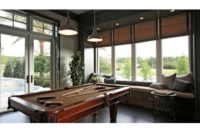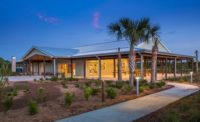Zero Energy America Homes creating Freer Future








Marc Rutenberg Homes is striving to create a net-zero energy path of the future. The company’s most recent projects, the Zero Energy America homes, are the fruits of this labor. In every aspect, these homes are designed to exceed the highest green building standards, providing the healthier, cost-effective and sustainable alternative in home design and construction.
The first completed homes, and those still under construction, are scattered throughout Florida—each differing in personal design preference but maintaining the exact same value of selecting extremely sustainable construction options. Ashley Rutenberg, LEED AP Homes, the Zero Energy America Homes’ project coordinator, was also the internal green building consultant. She says there are two different generations of design in the four Zero Energy America homes. The first two of the net-zero ZEA homes were completed in September 2012. ZEA 3 was completed near the end of 2012, while ZEA 4, the upcoming second-generation home of Zero Energy America, is expected to be completed in May 2013.
“The first generation maintained the Florida-Mediterranean style that is so dominant in the local market, with stucco walls, barrel-tile roofs, and a transitional interior,” Ashley Rutenberg says. “The upcoming second-generation home is pushing the envelope of the local market in Florida with a more contemporary style of architecture but still maintaining a warm, organic and soft palate of materials so that it stands as a comfortable and inviting home. The goal in the design change from the first home to the second was to bring newer, fresh ideas, concepts and living spaces.”
INTERIOR CHOICESFrom the interior design choices of the low-VOC paint in the bedrooms, the ethanol burning fireplace, and the roof pavers to the power generation of the building envelope, the 4,500-square-foot plus ZEA homes were designed to incorporate every available alternative to become an example for future net-zero energy homes down to the very last detail. “In these homes specifically, we used Icynene spray foam insulation at the top of the attic, which allows our HVAC equipments and ducts to be in conditioned space and prevents creating a super-heated attic,” says Rutenberg. “Think: Why build an oven and then try to cool it when you could just cool against the outside air temperature? We used either Hebel AAC walls, which are concrete blocks with high thermal performance in and of themselves, or Dow XPS insulation.”
Dow played its biggest role in the fourth ZEA home still in the works. “For the Breakwater Model at Champions’ Club, engineers helped us to design a wall system that matches Aerated Autoclaved Concrete in thermal performance (R-value) but without the significantly higher material cost of AAC. We designed the wall with 2 inches of Dow Extruded Polystyrene (XPS) insulation—where typically 3/4 inches would have been used—and a 2-inch chase wall so that the insulation does not have to be continually broken by all of the electric wires, plumbing lines, HVAC lines, A/V wires and other MEP components that go in the walls of a home,” says Rutenberg.
For power generation of the net-zero energy home, the Rutenberg team used LG Solar Panels, which have supplied more than 100 percent of the electricity needed to power the homes so far. Because Rutenberg used optimized scroll or rotary compressors, specially designed heat exchangers and inverter technology, VRF systems from LG were also used for the home for minimizing energy use to levels unattainable through traditional HVAC systems. Kevin McNamara, vice president of LG, says in the ZEA home, the LG VRF systems had small ductwork that increased attic storage space and a quiet operation, not to mention a cooling-load of nearly nine nominal tons.
Despite the ZEA homes’ emphasis on certain sustainable aspects, such as daylighting, ventilation and building insulation, don’t call they don’t meet the definition for Passive House. “A Passive House does not necessarily use net-zero energy, and indeed, it would be exceedingly difficult to make every aspect of a home passive—for example, refrigerators and other appliances, heated water, lighting for nighttime and heating on the coldest days are things that a 100 percent passive home could not accommodate,” says Rutenberg.
The ZEA homes are regarded more so as a net-zero home because the homes were specifically designed first to reduce the amount of energy they use through a combination of strategies. These strategies include a passive design, but also include aspects like Energy Star appliances, LED lighting and solar water heating. Then, renewable energy sources, such as solar, wind, and tidal for example, are used to supply the home with electricity in place of the power grid or generator fuel.
|
Location: Tampa, Fla. Owner: Marc Rutenberg Homes, Tarpon Springs, Fla. Size: 4,552 square feet (Castaway III Model) |
Featured Products:
|
“The key components of a net-zero home are used as renewable energy source—the envelope, HVAC and ventilation, and lighting and appliances. A net-zero home requires a ‘tight’ envelope, including the vinyl, insulated windows with low-E coating, insulation and air penetration barriers. The placement of the attic insulation is hugely important in a warm-climate home. Correct placement of the insulation at the roofline—not at the bottom of the attic by the truss chords—prevents having to cool the house against a superheated (140 degrees Fahrenheit) attic, and increase both the R-value of the insulation and prevent air infiltration by either sealing or using a combination product like spray-foam insulation that both insulates and seals the indoor air space from the outside,” says Rutenberg.
Increasing the R-value of the wall system, as well as designing a more continuous insulation blanket that isn’t broken at every 18-inches or 2 feet near studs, is another important feature in net-zero homes. Accurate third-party load calculations for correct sizing of the HVAC system is hugely important, as well as then specifying highly efficient HVAC equipment—such as a variable refrigerant system followed by high SEER-rated conventional equipment.
THE FUTURE IS ZERO“At the grand opening of the Castaway Model III in November 2012, we announced our plans for the Zero Energy America Village, which will be our first community of net-zero homes in a 1,600- to 2,300-square-foot range with pricing starting at $250,000,” says Rutenberg. “In these homes, a greater proportion of the sustainable focus will be directed toward energy specifically, though still with a consideration for more sustainable choices in all areas of construction and additional customer options that will allow those who desire it to build a ‘mondo-beyondo’ green home as we have done with the first Zero Energy America homes.”
In regard to the notion that sustainability goes hand-in-hand with conserving energy and resources, addressing questions about the size of the net-zero home is something the Rutenberg team has been learning to excel at. “This is our favorite [topic], because we feel it’s one of the most important to address,” Rutenberg says. “There will be many schools of thought and angles of approach to reducing our carbon footprint. Some people will be willing to change themselves and their own habits, and others simply will not; you can’t always change people. We praise those who are willing to go the extra mile and change their own habits, but we also wanted to offer a way for people to live as they always have and still have a net-zero home with no carbon footprint. This is why we built homes that fit beautifully amongst their neighbors in a luxury community and have no additional demands on the homeowners that live in them. As long as the market for big, beautiful, luxury homes is so high in demand, we will find the way to make them big, beautiful, luxurious and green."
Looking for a reprint of this article?
From high-res PDFs to custom plaques, order your copy today!









